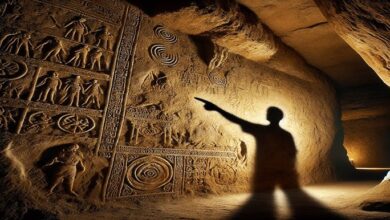Ghost Ship Mary Celeste: The 150 Year Mystery

On December 13, 1872, the Mary Celeste, a battered old brigantine, was found drifting into Gibraltar harbor with only three crew members on board. The ship was rescued by three men from the De Gratia after the Mary Celeste was discovered drifting in the middle of the Atlantic Ocean without any sign of its original crew. The greatest mystery is the disappearance without a trace of the captain, his family, and seven other sailors on board.
What is strange is that the ship is still in almost perfect condition, with no signs of struggle or disaster, making the story one of history’s greatest maritime mysteries. The story has been told and rewritten countless times over the past 150 years, but the truth remains elusive.
The Mary Celeste was not the first ship to disappear at sea, but the disappearance of its crew without a trace makes it unique. To understand this, we need to go back to when the ship was built in Spencer’s Island, Nova Scotia, in 1860. Originally named the Amazon, the ship was built by Joshua Dewis, a local shipbuilder. After a series of accidents and strange events, the ship changed hands and was renamed the Mary Celeste.
On her final transatlantic voyage, the Mary Celeste was en route from New York to Genoa, Italy, with a cargo of industrial alcohol. But when she was discovered, the entire crew had disappeared, leaving many unanswered questions.
Winchester was being blackmailed: if he paid the import fees immediately, the case against him would be dropped. He resisted, leading to a legal battle in which he eventually won. However, he discovered that Haynes’s claim of spending $8,000-$9,000 on rebuilding the Mary Celeste was false. The ship was actually in such poor condition that it required an $11,500 overhaul. Winchester had to sell a third of the vessel to Captain Benjamin Briggs from Massachusetts, who took command and set sail from New York to Genoa, Italy.
Captain Briggs, an American with a family, had his wife and daughter accompany him on the voyage. They spent time on the ship while it was docked at Pier 50, New York. On November 5, 1872, the Mary Celeste finally departed but faced delays due to weather.
Another ship, the De Gratia, similar in design and heading to Genoa as well, set sail a week later. Both ships encountered rough weather, and the De Gratia reached the Azores around December 5. Captain Morehouse of the De Gratia noticed the Mary Celeste drifting erratically and sent a crew to investigate. They found the ship abandoned with tattered sails and missing items, but no crew or signs of distress.
Devoe inspected the Mary Celeste and found everything inside was wet, with many windows boarded up to protect against the storm. The cabin skylight was left open, allowing rain to soak the interior. The captain’s and family’s beds had been slept in but were not made, indicating the crew had left early that morning. The impression of the two-year-old’s bed was still visible. Most personal belongings were left behind, except for items lost in a previous shipwreck.

The ship had enough food and water for the rest of the voyage, and nothing substantial was missing except for what had been consumed early on. The logbook was updated until November 24, and the log slate had the start of an entry for November 25. The crew of the De Gratia, finding the Mary Celeste in good condition, decided to salvage it. They repaired and prepared it for sailing, reaching Gibraltar with the ship in working order.
Investigators later found no sign of struggle, though a sword under the captain’s bed was found rusty with no blood. Theories ranged from murder for insurance to piracy, but none were substantiated. The idea of a violent crew capture by the De Gratia was deemed improbable due to the lack of signs of struggle and the slower speed of the De Gratia. Other theories included natural disasters or even fictional accounts by authors like Arthur Conan Doyle, who sparked interest in the mystery.
The most plausible theory suggests that the Mary Celeste’s cargo of alcohol caused dangerous fumes to build up. During a break in the storm, the crew likely opened the hatches to ventilate, but the fumes could have led to panic or disorientation, causing them to abandon ship.
The Mary Celeste, with its cargo of alcohol, likely suffered from dangerous fumes that accumulated in its hold. These fumes could have caused the ship to creak and groan, alarming the crew. Captain Briggs faced a grave choice: stay on the ship or risk an explosion by venting the fumes. Ultimately, he chose to abandon the ship, taking his family and crew in the lifeboat. They had limited time to prepare and were caught in worsening weather, making their chances of returning to the ship or reaching safety slim.
Records indicate that the Mary Celeste drifted for days before being discovered by the De Gratia. The ship’s log was lost, and while some theories involved murder or piracy, these were not supported by evidence. The most plausible explanation suggests the crew panicked due to the fumes and was unable to return to the ship or reach safety.
Following the investigation, the Mary Celeste’s haunted reputation led to its eventual decline. Sold multiple times, it was intentionally wrecked in 1884 as part of an insurance scam. The scheme involved over-insuring the cargo and deliberately running the ship aground. The wreckers were eventually caught, and the ship’s final destruction was marked by misfortune for those involved. The Mary Celeste remains a legend, its true fate a mystery intertwined with misadventures and deceit.
The Mary Celeste’s story concludes with a series of notable events. After the ship’s final wreck, both the Mary D Douglas and the Saxon, which were involved in investigating and handling the wreck, were lost on their very first voyages.
A monument at the site where the Mary Celeste was built in Spencer’s Island, Nova Scotia, commemorates its connection to the infamous ship. Despite an offer to repurchase the vessel after its wrecking in Haiti, the builders declined. Today, the site offers tours and campouts through local adventure programs, providing a chance to experience the historic area.
In 2001, the Eco Nova Scotia company, in collaboration with author Clive Cussler, identified what they believed to be the remains of the Mary Celeste off the coast of Haiti. Artifacts recovered include deck nails, copper sheathing, and ballast rock, which are displayed at the Age of Sail Museum in Port Graville, Nova Scotia. This museum offers an in-depth look into shipbuilding history and features a dedicated display for the Mary Celeste.
The Mary Celeste has become emblematic of the ghost ship legend, capturing the public’s imagination with its mysterious abandonment and enduring legacy. If you’re interested in maritime history or ghostly tales, you might find the Age of Sail Museum a fascinating destination.
For more details or to support similar content, consider visiting the channel or the associated Patreon supporters listed in the video credits.








